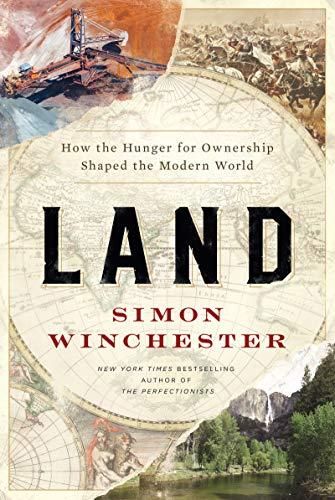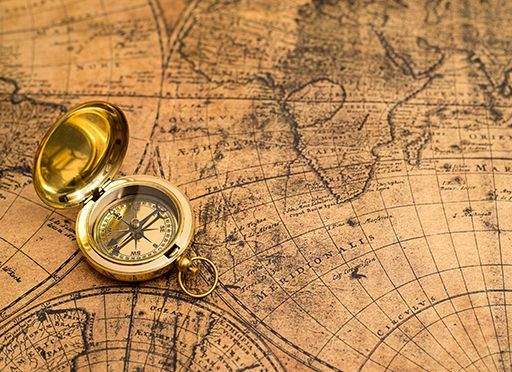Prolific bestselling historian Simon Winchester provides telling, illuminating examples of human interaction with land and with one another in land disputes.

Everybody Wants Land
Bestselling author Simon Winchester’s history of humanity’s use and abuse of land is both inspiring and heartbreaking. He illuminates how land has served as a catalyst for humankind’s greatest achievements, tragedies and atrocities. Winchester, an officer of the Order of the British Empire (OBE), traces the myriad ways people engage with land: revering it, buying and selling it, stealing it, dividing it, fighting over it and – in recent times – striving to preserve it.
Land Ownership
Many ancient societies believed that the Earth’s surface belongs to a deity or several deities and that all people share its use. Individual ownership of land most likely arose about 4,000 years ago as people stopped living as nomadic hunter-gatherers.
Within a garden fence there is just the simple matter of ownership; within an urban boundary there is usually the concept of jurisdiction, there is tax collection, there are powers of police and provision of services, there is the nuanced complexity of government. Simon Winchester
People marked the boundaries of their land with stones, and then progressed to fences and, eventually, to legal agreements. Today, 317 international borders demarcate Earth, the largest being the 5,525-mile border between the United States and Canada.
Mapping the Earth
In 1891, the delegates at the Fifth International Geographical Congress committed to the International Map of the World (IMW) project, mapping all 37 billion square miles of the planet’s land at a scale of one to 1,000,000 inches. The project set out to draw detailed sheets, each depicting four degrees of latitude and six degrees of longitude.
In time, the advent of air travel, with its demand for views from above, hobbled the mapping project. In 1947, more than 50 nations formed the International Civil Aviation Organization and gave it a mandate to produce aerial charts of the world’s surface. The IMW project limped along until the United Nations closed it, unfinished, in 1986.
European Imperialism
In the 18th and 19th centuries, European nations claimed ownership of any land they discovered, no matter who already lived there.
Spanish and British colonists and, later, American settlers, expanded their reach. Settlers moved westward, pursuing what they called Manifest Destiny to take land from Indigenous peoples. Native American tribes believed that land belongs to everyone, and they put little stock in owning or selling it.
When those who lived on the coasts first glimpsed with astonishment the white sails of the tiny inbound flotillas, they can have had no apprehension whatsoever of the savage interruption – of the apocalypse, indeed, the holocaust – that was about to despoil their serene and settled lives.Simon Winchester
A central principle of land ownership is that the owners can exclude others from being on their land. The United States strictly enforces this: A trespasser must leave when an owner says to go. Scandinavia, Belarus and Switzerland have a relaxed attitude toward private land access. In Scotland, visitors can enter any land any time, if they adhere to Scotland’s detailed Outdoor Access Code.
Internment of Japanese-Americans
In 1920, the 2% of California’s population that was Japanese produced 12% of the state’s agricultural products. By 1941, Japanese people made up 3% of California’s population and produced 42% of its crops. Racist organizations – such as Native Sons of the Golden West and the Asiatic Exclusion League – sought to restrict Japanese immigration.
The Japanese attack on Pearl Harbor in 1941 precipitated President Franklin D. Roosevelt’s signing of Executive Order 9600, which interned hundreds of thousands of Japanese-Americans in camps.When finally freed, many Japanese-Americans found that local governments or their fellow residents had confiscated their land.
New Zealand
Since the 1970s, New Zealand has sought to recognize the indigenous Maori people. An 1840 treaty led to 30 years of land wars between the British and the Maori. The victorious British appropriated 3.5 million acres of Maori land.
The reforms enacted in New Zealand over the years since the Land March have been considerably more substantial than in those other settler states. Simon Winchester
In the 1970s, Maori leader Whina Cooperstarted a movement to reclaim her people’s ancestral lands. She led a march across New Zealand’s North Island to the capital of Wellington, where she presented a petition to the government. The government investigated the consequences of the 1840 treaty. In one dispute, the government paid local Maoris about $170 million, and Queen Elizabeth II issued a formal apology. Many New Zealanders think the government should return the land the country seized to the Maori.
Community-Owned Land
Indigenous people believed in communally owned land, as did commoners in England. For example, people in the Middle Ages might claim an acre or two for personal farming, and otherwise they used the commons – lands where everyone could graze livestock or cut wood. The eventual enclosure of common property and the advent of rules against trespassing shaped land ownership.
A mere 432 families own half of Scotland. In 2016, the Scottish National Party passed a law forbidding landowners to sell land to individuals. They can sell only to communities that promise to pursue sustainable development. Such communities own 600 plots totaling half a million acres, including the islands of Ulva and Eigg.
If properly and fairly apportioned, land can be the key to so many possibilities, all of them for the general benefit of those of us who live and work and have our being upon it.Simon Winchester
In the United States, land trusts have returned some land to common ownership, such as the Rocky Narrows, 274 acres of Massachusetts wilderness. Since 1897, the local community has owned the land as trustees through the state’s Trustees of the Reservations. Under a nationwide trustee movement, philanthropic landowners can donate land or grant a conservation easement.
The United States has around 1,300 small-town land trusts and 250 community land trusts; England, Wales and Scotland have 255 community land trusts.
Rising Sea Levels
Land is disappearing as rising seas nibble away the coasts.The seas are rising as ice melts in the northern and southern polar regions. As the ice thins, polar land absorbs more solar heat, which accelerates its melting, thinning the ice and increasing heat absorption.
The land is drowning.Simon Winchester
Encroaching water threatens to submerge low-lying areas, including island nations.Major landowners, most of whom own property in interior areas with higher elevation interior, can avoid worrying about rising seas. So, they don’t.
Dispassionate History
Winchester writes in elegant, classical-historian prose about tragedies, atrocities and predicted disasters using a historian’s dispassion. He takes a sympathetic view at times, but he’s never polemical. He seeks to describe people’s relationships to land, no small subject, which explains the book’s size. You can feel him making discoveries that surprise him, and that adds to the power of his account. A superb work for students, Winchester’s treatise will fascinate all adults.
Simon Winchester’s other books include The Perfectionists: How Precision Engineers Created the Modern World; The Men Who United the States: America’s Explorers, Inventors, Eccentrics and Mavericks and the Creation of One Nation, Indivisible; Outposts: Journeys to the Surviving Relics of the British Empire; Krakatoa: The Day the World Exploded: August 27, 1883; Pacific: Silicon Chips and Surfboards, Coral Reefs and Atom Bombs, Brutal Dictators and Fading Empires; and A Crack in the Edge of the World: America and the Great California Earthquake of 1906.







